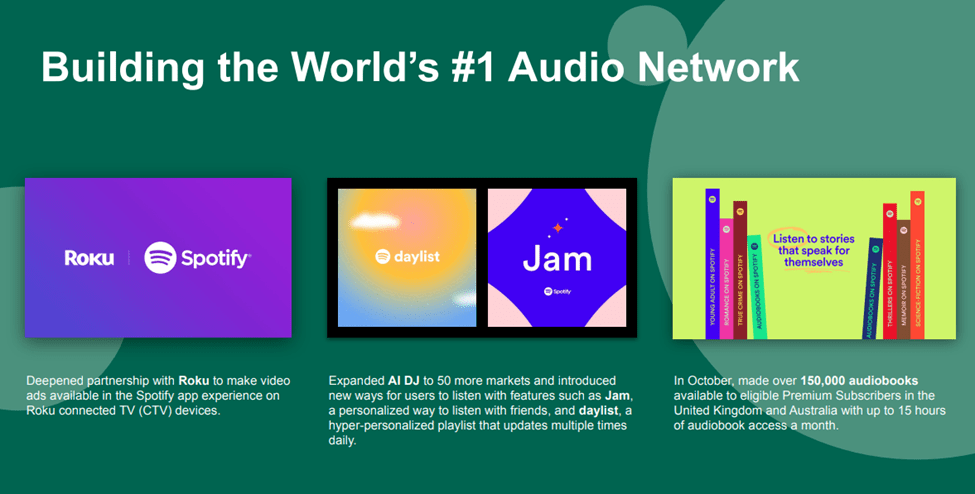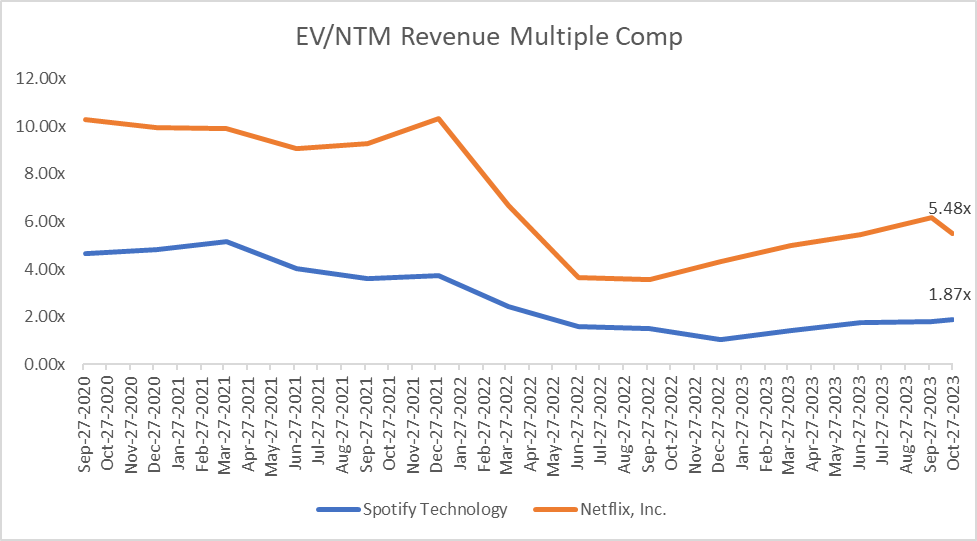Investment Thesis
Spotify Technology S.A.’s (NYSE:SPOT) growing exposure to podcasting and advertising could counterbalance any potential slowdown in user growth and ultimately improve its profitability in the long term. The company currently boasts 195 million premium subscribers and 456 million monthly active users. Its path to sustained profitability largely depends on effectively leveraging podcasts, as music content owners hold a strong position in negotiations. I believe Spotify’s ownership of podcast content could be a significant driver for growth, especially as the pressure from previous heavy investments begins to ease. The company’s robust revenue growth, monthly active user growth, and additions of premium subscribers provide a solid foundation for its margin improvement and valuation. I am positive that the company will continue to improve on its user growth and profitability metrics in the future and hence assign a buy rating to the stock at current levels.
3Q Review and Outlook
Spotify performed better than expected in terms of user metrics in the third quarter, but there are challenges ahead for improving its gross margin. In the third quarter, the gross margin was reported at 24.7%, slightly below the targeted 25.2%, and the company is expected to post GM margin of 24.5% in the fourth quarter. Expanding the gross margin is crucial for the company, and it has strategies in place, including efforts in advertising, podcasting, and its Marketplace business. However, executing these strategies effectively is key.
Spotify is now paying more attention to cost control. In January, it reduced its workforce by 6%, and in June, it carried out another round of layoffs, particularly in the podcasting division, as part of a broader restructuring. The company has been emphasizing better discipline in managing both new and existing projects, which suggests there’s room for further cost-cutting. Reducing spending on podcast content (after investing $1 billion over the past four years), trimming marketing expenses, and workforce reductions are expected to contribute to this effort.
While Spotify continues to experience strong user growth, the industry is shifting its focus toward profitability rather than rapid expansion. Gradual price increases should help with profitability; although the impact may not be significant in the short term, I expect it to contribute positively to profits in the long run.
Podcasting Investments To Pay Off In the Long Term
Spotify dominates US podcasting, with $215 million in 2021 revenue and around $300 million in 2022, yet it dragged down 2021 gross profit by $110 million. With the US podcast market expected to double over the next few years from $1.8 billion in 2022, the company has been investing heavily in technology to improve monetization, though this has created a heavy pull on margin. A flip in the narrative hinges on scaling up podcasting ads, and with the hefty investments done, guidance for breakeven in the next 1-2 years may be achievable even as economic weakness limits visibility. Spotify owns exclusive programs such as “The Joe Rogan Experience,” which causes margin pain vs. its third-party, better-monetized business. Spotify expects podcasting to be a $20 billion market in the long term, which is why the company has continued to invest in this side of the business heavily in the past.
Margin Improvement To Continue
In 2021, Spotify’s core music business achieved a gross margin of 28.3%. This was partly due to its two-sided Marketplace business, which contributed to a 75 basis points annual expansion in gross margin between 2018 and 2021. This success has led Spotify to set a target of reaching a 30% gross margin within the next 3-5 years and eventually aiming for a long-term goal of 35%.
In 2022, Spotify’s Marketplace business generated approximately 210 million euros in gross profit, primarily driven by two artist tools. The first tool, called Discovery Mode, was introduced in 2020 and serves as a marketing device that allows artists to benefit from algorithmic promotion. It has low barriers to entry, with no participation costs, although artists must forego some royalties on the streams generated through it.
On the other hand, Marquee is a self-service advertising tool that enables sponsored recommendations for new releases. Marquee has been experiencing significant growth with strong revenue gains and has substantial potential for improving margins. I believe both of these tools have promising runways and will contribute to margin upside.
Company Presentation
Financial Outlook
Spotify has been heavily investing in podcasts, but now it’s scaling back on that investment, which should improve its gross margin. With careful cost management, growing user numbers, and potential price hikes, Spotify aims to achieve a 30% gross margin in the long run. While progress has been slow, hitting 24.7% in Q3, Spotify’s reduced focus on podcasting and increased emphasis on its Marketplace unit suggests that the 30% target might be attainable in the medium term. To achieve this, Spotify plans to reduce spending on podcasts and audiobooks and make better use of its two-sided Marketplace music segment. Moreover, I believe to improve profitability, Spotify needs to diversify its revenue streams, particularly through advertising. The core music business isn’t highly profitable because a few major players control music programming, limiting Spotify’s leverage. Therefore, adding new revenue sources, especially advertising, is crucial to enhancing Spotify’s profitability.
Ultimately, Spotify is aiming to increase user engagement to retain subscribers and reduce churn. This not only strengthens its pricing power but also creates more advertising opportunities, leading to higher margins and long-term earnings growth.
Valuation
I believe the comparison between Netflix, Inc. (NFLX) and SPOT’s valuations is relevant given their similar business dynamics, such as their shared global target audience for streaming content. However, there are noticeable differences. NFLX possesses a wealth of exclusive content, leading to higher margins, while SPOT primarily distributes content in a more segmented market.
Though it wouldn’t be correct to assume that NFLX and SPOT should have identical valuation multiples, tracking the comparative premium of NFLX to SPOT over time can be insightful. Recently, both companies experienced stock declines in 2022, prompting questions about their long-term growth prospects. NFLX faced concerns about its subscriber growth, whereas SPOT’s worries centered on margins, leading to a significant investor event in June 2022. Despite these challenges, the outlook for both companies has since become more optimistic.
Traditionally, NFLX has enjoyed a valuation advantage over SPOT, reflecting NFLX’s stronger operating margins. Currently, as per Capital IQ estimates, SPOT is trading at a forward EV/Revenue multiple of 1.87x compared to NFLX, which is trading at 5.08x, implying a 63% discount, which leaves significant room for upward multiple re-rating. Over the past five years, SPOT has traded at an average forward EV/Revenue multiple of 2.9x, leaving significant upside if the current multiple were to revert to the 5-year mean. The company has been making strides toward achieving long-term margin expansion, and operating income losses are decreasing and the company is expected to break even on an operating income basis in the first quarter of 2024. The company’s robust revenue growth, monthly active user growth, and additions of premium subscribers provide a solid foundation for its margin improvement and valuation. Additionally, Spotify possesses the ability to implement price hikes, which could lead to higher gross margins through negotiations with music labels and services like Marketplace. I believe the company’s continued execution on margin improvement can lead to an upside in the valuation level from here. Hence, I remain positive on the stock and assign a buy rating to SPOT.
Capital IQ
Investment Risks
Achieving Profitability is a key challenge for Spotify, and its success hinges on the company’s margin improvement. However, investors are now becoming less patient in this regard. The management acknowledges that the path to better margins is not straightforward, and while their focus on margin improvement has increased over the years, there may still be pauses for new investments. Any delays in the company’s target of achieving 30% gross margin in the medium term can cause a downside in the stock price. Spotify faces competition from various players, including Apple, Google, Amazon, as well as smaller companies and traditional radio services. This competition is particularly challenging because most of the engagement revolves around music, which is common to all competitors. This poses a risk of limitation in the potential for margin improvement.
Conclusion
Spotify currently has an impressive 195 million premium subscribers and 456 million monthly active users. Its sustained profitability relies heavily on effectively utilizing podcasts, given the strong negotiating position of music content owners. I believe that Spotify’s ownership of podcast content could be a significant growth driver, especially as the pressure from substantial past investments starts to ease. I am positive on the prospects of the company and assign a buy rating to the stock.
Read the full article here



